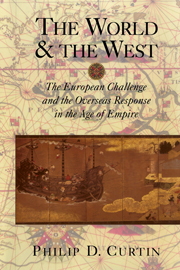Book contents
- Frontmatter
- Contents
- Preface
- Part One Conquest
- Part Two Culture Change and Imperial Rule
- Part Three Conversion
- 7 Christian Missions in East Africa
- 8 Varieties of Defensive Modernization
- 9 Meiji Japan: Revolutionary Modernization
- 10 Ottoman Reactions to the West
- Part Four Independence and the Liquidation of Empires
- Index
10 - Ottoman Reactions to the West
Published online by Cambridge University Press: 05 June 2012
- Frontmatter
- Contents
- Preface
- Part One Conquest
- Part Two Culture Change and Imperial Rule
- Part Three Conversion
- 7 Christian Missions in East Africa
- 8 Varieties of Defensive Modernization
- 9 Meiji Japan: Revolutionary Modernization
- 10 Ottoman Reactions to the West
- Part Four Independence and the Liquidation of Empires
- Index
Summary
The Ottoman Empire and the Japanese Empire met the Western threat in vastly different circumstances. In the Muslim world, the Ottoman Empire was one of the three new Islamic centers in the Age of Three Empires, the others being the Mughals in India and the Safavids centered on Persia. From the 1300s, Ottoman territory was at the very borders of Christian Europe, and, in the 1400s and 1500s, it was southeast Europe that faced an Ottoman threat. In 1453, the Ottoman capture of Constantinople had destroyed what remained of the Byzantine Empire and put a Muslim empire in its place. Through the 1500s, the Turks were militarily equal to almost any Western power, often superior. On the world scene, the Ottoman Empire was one of the emerging gunpowder empires.
In the 1600s and after, the balance of military power gradually shifted toward the West. The Ottomans, like the Japanese, were not at first conscious of the power emerging in Europe, though signs were visible, at least in retrospect, even before the full industrialization of the 1800s. The Ottoman leadership, moreover, was well informed about Europe, though the cultural chauvinism common in the Muslim world of the time sometimes led them to discount the European threat. By the 1790s, however, a significant minority had become alarmed. In this, they were about a half-century ahead of Japan, where recognition of the Western danger did not reach an equivalent level until the events of the 1840s.
- Type
- Chapter
- Information
- The World and the WestThe European Challenge and the Overseas Response in the Age of Empire, pp. 173 - 192Publisher: Cambridge University PressPrint publication year: 2000



